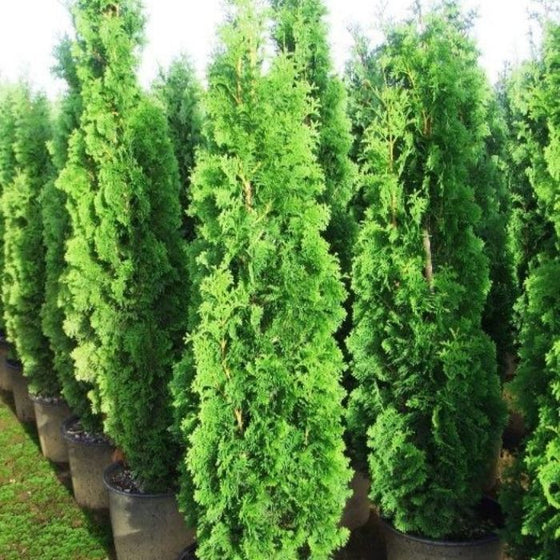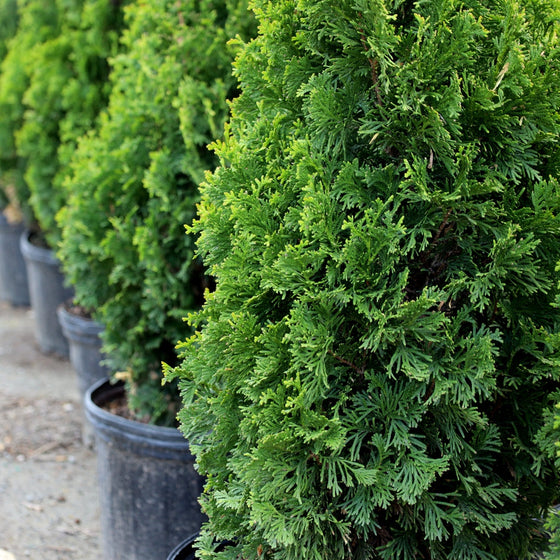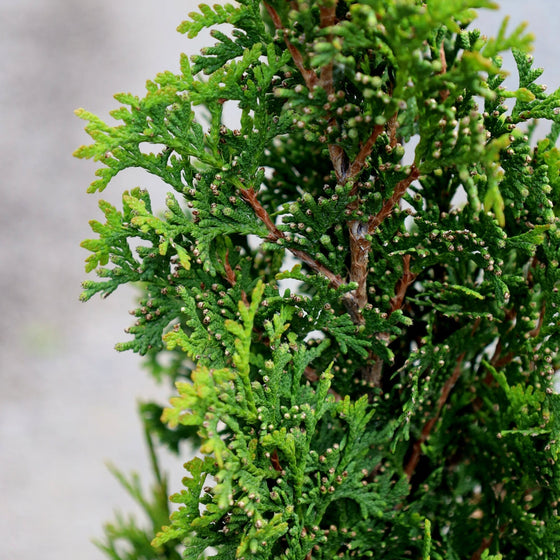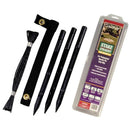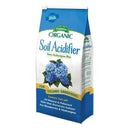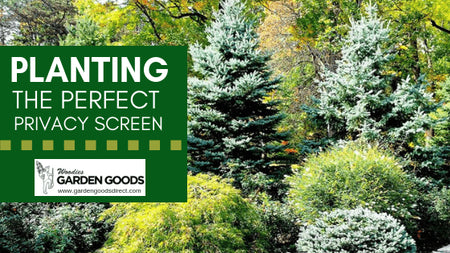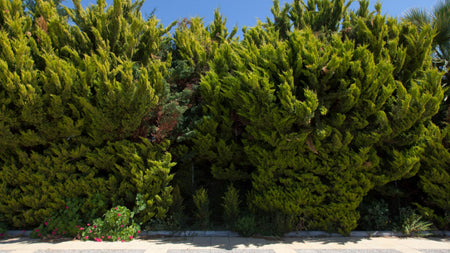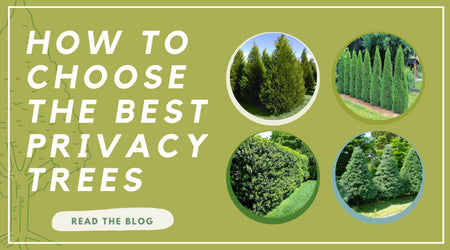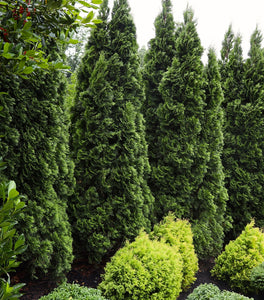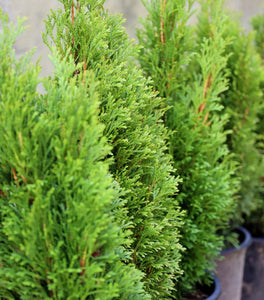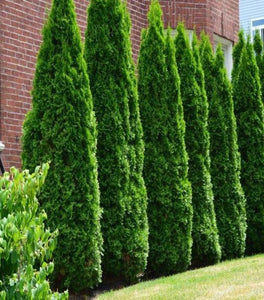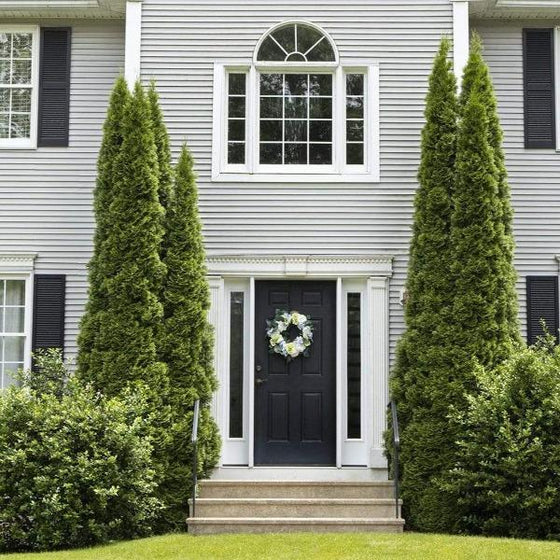
Images Depict Mature Plants
DeGroot’s Spire Arborvitae – Narrow Columnar Evergreen for Privacy and Small Spaces
A unique upright evergreen with a slim profile.
The DeGroot’s Spire Arborvitae (Thuja occidentalis ‘DeGroot’s Spire’) is an elegant, narrow evergreen that brings height and structure to small landscapes. With its dense, upright growth habit, this arborvitae is prized for its tall, columnar shape and adaptability in both formal and casual gardens.
Perfect for privacy in tight spaces.
Unlike broader privacy trees, DeGroot’s Spire grows to 20–30 feet tall but just 3–5 feet wide, making it an excellent choice for small yards, narrow borders, and tight property lines. Whether planted as a single specimen, used in rows as a hedge, or framing entryways, this Thuja creates a refined, evergreen statement that doesn't overwhelm smaller spaces.
Cold-hardy and low-maintenance.
Hardy in USDA Zones 3–7, DeGroot’s Spire Arborvitae thrives in full sun to partial shade and tolerates a variety of soils as long as they drain well. Its naturally dense form requires little pruning, and its slow-to-moderate growth rate ensures it keeps its slim, upright shape for years with minimal maintenance.
A classic evergreen with modern appeal.
DeGroot’s Spire offers the year-round greenery and durability of traditional arborvitae but with a slimmer footprint perfect for today’s landscapes. Whether you need a low-maintenance privacy tree or an architectural vertical accent, this arborvitae delivers timeless style and dependable performance.
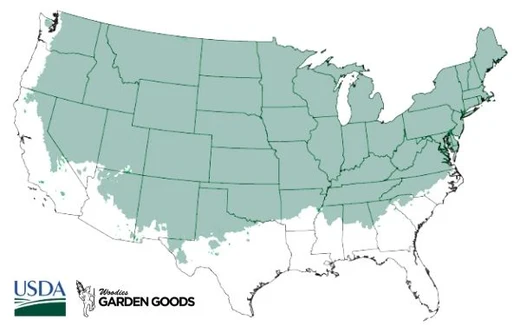
| Hardiness Zone | 3-8 |
|---|---|
| Mature Height | 20 to 30 Feet |
| Mature Width | 3 to 5 Feet |
| Sunlight | Full sun |
| Foliage Color | Dark green |
| Growth Form | Dense upright and conical |
| Soil Conditions | Grow best in average, medium moisture, well-drained soils. Will not tolerate extremely dry conditions |
| Water Requirements | Well drained soil |
How to Care for DeGroot's Spire Arborvitae
Before you buy a Degroot's Spire Arbovitae Tree, make sure to read about the recommended care instructions to keep this plant healthy and thriving.
How do I plant DeGroot’s Spire Arborvitae?
How do I plant DeGroot’s Spire Arborvitae? Choose a site with full sun to partial shade and well-draining soil. Dig a hole twice as wide as the root ball but no deeper. Place the tree upright, backfill halfway, water thoroughly, then finish filling the hole and water again. For hedges, space DeGroot’s Spires 3–5 feet apart for a seamless evergreen wall. Apply a 2–3 inch mulch layer around the base to conserve moisture and suppress weeds, keeping mulch away from the trunk.
How often should I water DeGroot’s Spire Arborvitae?
Water regularly during the first year to help establish deep roots, typically once or twice per week, depending on rainfall and soil type. Once established, DeGroot’s Spire is moderately drought-tolerant but will benefit from occasional deep watering during dry periods. Consistent watering during the first growing seasons ensures stronger growth and denser foliage.
When and how should I fertilize DeGroot’s Spire Arborvitae?
Fertilize in early spring with a balanced, slow-release fertilizer formulated for evergreens. Spread evenly around the root zone and water well to activate nutrients. In most cases, one annual feeding is sufficient to support healthy growth. For younger plants or those in poor soils, a second light feeding in midsummer may be helpful.

Does DeGroot’s Spire Arborvitae need pruning?
DeGroot’s Spire naturally grows in a slim, columnar form and requires little pruning. If shaping is desired, prune lightly in late spring or early summer to maintain symmetry. Avoid cutting into old wood, as arborvitae do not regenerate from bare branches. With its tidy form, pruning is typically optional.

